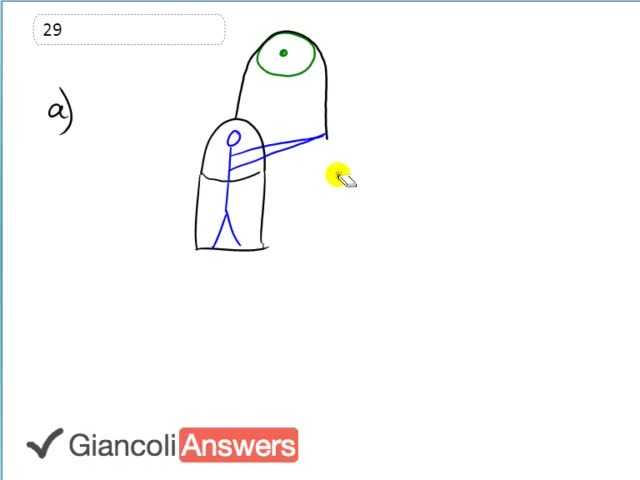
b)

In order to watch this solution you need to have a subscription.
This window washer in the bucket is pulling down on the rope and that means the rope in turn pulls up on the window washer, that’s Newton’s third law. So we’re going to draw an arrow which is the force that the window washer experiences due to the rope and it’s the reaction force to window washer pulling down on the rope. And there’s tension on the rope now the washer is pulling on it and this tension will also pull the bucket up which will in turn pull the person up. So the window washer is experiencing the force that he’s pulling on the rope with twice, he experiences that force once as a reaction on his hands by the rope pulling up and then experiences it again through the bucket pushing on his feet upwards and that force will be due to the tension in the rope which is equal to the force that he’s pulling on the rope with. I hope that explains why there are two arrows pointing up equal to the force that the window washer is pulling down. There is also the force of gravity on the window washer downwards. So all three arrows are forces on the washer and it’s probably easier to draw it as a simplified free body diagram. Just imagine the window washer is a box and put force arrows on it. This green one is going to be two times the force that he’s pulling on the rope with and then we have gravity downwards. And in part a he’s going at a constant velocity so these arrows are of equal length. So let’s figure out what that force will have to be assuming that he’s weighing sixty five kilograms. Newton’s second law says: the up forces, two times the pulling force minus the down forces equals mass times acceleration which is zero in part a since there’s no acceleration and then we’ll add ‘Fg’ to both sides so we have: two times pulling force equals force of gravity which is ’m’ times ‘g' and then we can solve for the pulling force by dividing both sides by two so it’s his weight divided by two, sixty five kilograms times nine point eight newtons per kilogram divided by two, the pulling force is three point two times ten raised to power two newtons. And what you’re seeing here is the mechanical advantage of a pulley. So part b: we’re going to assume he’s going to pull with fifteen percent more force and what will be the acceleration in that case? The pulling force in part b is going to be fifteen percent more, so that’s one point one five times the original force, the one is there because we’re going to be adding fifteen percent to the original amount so we have a hundred percent plus an additional fifteen percent, and that gives us one point one five times three hundred and eighteen point five newtons equals three hundred and sixty six point two eight newtons and then again we have the same Newton’s second law, two times pulling force, but we’ll use pulling force two in this case, minus gravity equals mass times acceleration. This was zero in part a but that’s no longer true and then we’ll solve for ‘a’. Divide both sides by ‘m’ we have ‘a’ equals two times this new pulling force minus ‘m’ times ‘g’ divided by ‘m’ and that gives two times the original pulling force for constant speed minus sixty five kilograms times nine point eight newtons per kilogram divided by sixty five kilograms this gives one point four seven zero, better written as one point five meters per second squared. So this is how fast the window washer will accelerate upwards when he increases his force by fifteen percent more than the force needed for constant speed. In the 5th Edition he’s going to be having ten percent more force. So this is going to be one point one zero times three eighteen point five. So in the 5th edition he’ll have a force of three hundred and fifty point three five newtons resulting in an acceleration of zero point nine eight meters per second squared upwards in the 5th Edition
Hi Davjul,
Thanks for having such a sharp eye. Your calculation is correct, but when taking significant figures into account, the final answer is 320N. For subsequent calculations however, you would use 318.5N to avoid intermediate rounding error.
This answer it´s wrong¡¡ 65*9.8/2==318.5¡¡No 320